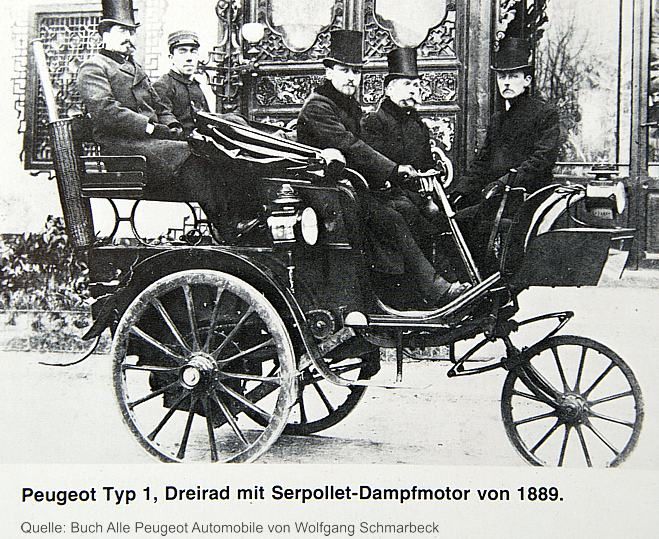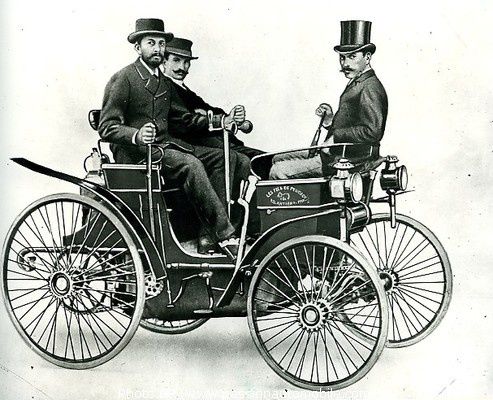WHY AREN'T FRENCH CARS SOLD IN AMERICA ?
The French automakers were the first to come into the USA and Canada at the end of the 19th century. At the beginning the French car industry was the most advanced and the French market was by far the largest.
The first car was l'Obéissante made in Le Mans, France in 1873. It had a steam engine. As anecdote, during the first drive in Paris, the driver received 73 fines although the car could not go over 30 mph...
The French pioneers worked hard to develop steam, electric and gasoline engines to determine the bases of the biggest industry in the world.
The gasoline engine had been created in 1860 in Paris by Etienne Lenoir but it only got patented in 1884 by Edouard Delamare-Deboutteville. The two first gasoline cars were produced in 1883 and 1884 but the chassis got destroyed during the testing and the project was abandonned. Meanwhile a first electric car engine had been designed in 1869, but it was only in 1881 that the first electric car was operated. In reality it was a bus to make the connection between Place de la Nation and Versailles ! As anecdote, the bus had 9 tons of accumulators !
It wasn't until 1886 that the Germans started to have an interest for cars. Close to Stuttgart, Daimler and Maybach created a very small air cooled gasoline engine which developed 1,1 horsepower. The German market didn't exist so Louise Sarazin - Daimler and Maybach representative in Paris - convinced Emile Levassor that France had a market for such a small engine. Emile Levassor thought immediatly to his client Peugeot Frères.
The Type 3 had the engine designed by Daimler, but was licensed for production in France by Panhard et Levassor and then sold to Peugeot. It was a 15° V-twin and produced 2 bhp, sufficient for a top speed of approximately 18 kilometres per hour (11 mph).
A lightened Type 3 was entered into the 1895 Paris–Bordeaux–Paris, finishing second and maintaining an average speed of 21.5 kilometres per hour (13.4 mph).
In the 60's and the 70's most the American carmakers were in France and the French Big Three (Peugeot - Citroën - Renault) were in North America. Chrysler had a specific brand in France called Simca which were imported into the USA.
Due to the regulation, some French cars had different headlights and bumpers in America.
Citroën North America suffered a significant financial blow during the 1973 oil crisis. In 1974, the carmaker withdrew from North America due to design regulations that outlawed core features of Citroën cars. Since 1974 Citroën never officialy came back to the USA or Canada.
The 80's were the beginning of the end for Peugeot and Renault in the USA and Canada.
The situation for Renault USA was very complex. In 1979 Renault bought American Motors Corporation when AMC was bankrupt. The agreement included a loan of 135 million USD to AMC and a place for renault in the US AMC dealerships. This came as good news to the already struggling AMC dealers in the US. In order to expand AMC, Renault decided to invest more by opening the Bramalea Assembly which was the most advanced automotive assembly plant in North America. Futhermore Renault found the way to sell some Jeeps to China in the middle of the cold war.
The Bramalea Assembly became of significant interest to Chrysler, who wanted to rent part of the advanced assembly lines to build their own cars. AMC could afford not to explore this option due to its significant financial backing from Renault.
In the mid-80's the sales were declining and AMC had to fight against rumours as they wercked some production lines. The Pentagon had also problems with AM General, a significant defense contractor, being managed by a partially French-government-owned firm. The U.S. government would not allow a foreign government to own a significant portion of an important defense supplier. As a result, the profitable AM General Division was sold.
Georges Besse, new Renault's CEO, continued to champion the French firm's future in the North American market, pointing to the company's completion of the newest and most-advanced automotive assembly plant in North America as well as the recent introduction of the thoroughly modern, fuel-injected 4.0 L and 2.5 L engines. In addition, Jeep vehicles were riding an unprecedented surge in demand. It seemed to Besse and others that AMC was on course for profitability. However, on November 17, 1986, Georges Besse, who had a high profile among French capitalists, was assassinated by Action Directe, a clandestine militant extremist group variously described as communist, anarchist and Maoist, which professed strong sympathies for the proletariat and the aspirations of the Third World.
Under pressure from Renault executives following Besse's death, Renault's new president, Raymond Levy set out to repair employee relations and divest the company of its investment in American Motors.
On March 9, 1987, Chrysler agreed to buy Renault's share in AMC, plus all the remaining shares, for about US$1.5 billion. Chrysler immediatly benefited from the new Jeeps and the new engines, easily recuperating their investment but changing to name from AMC to Eagle-Jeep. The buyout was an attractive deal for Chrysler.
Ironically the sale came at a time when the automotive press was enthusiastic about the proposed 1988 lineup of Renault and Jeep vehicles, and reports that the financial outlook for Eagle-Jeep were improving.
Afterward Renault left the North American car market. Nevertheless they partially came back in 1999 when Renault bought Nissan. Today some Nissan cars use Renault's chassis and you can easily find the Renault's technology in the Nissan and Infinity vehicules.
Regarding Peugeot, the situation was vastly more different. Peugeot had a prestigious image which participated at the expansion of the US car industry. For instance, Peugeot was the first non-american automaker to win at the Indianapolis Motor Speedway in 1913 with a speed of 150 kph / around 94 mph.
So why did Peugeot leave the North American market ?
Officially it was because of the price competition between American and Japanese automakers. Let's say that the 80's were not the best time for the US market. Automakers had to make significant price cuts to sell their inventories. Meanwhile Peugeot launched the all new 405, a great car with a positionning between the middle and premium market segments as Oldsmobile at the beginning of the 2000's.
Resulting was the failure of the all new 405, essentially pushing peugeot to stop producing cars for the North American markets even if the 605 was ready to be launched...
Basically, the French pioneers were a great inspiration for the world automakers, but the Second World War destroyed all the French know-how in high luxury production. However, some prestigious models had been made such as the Citroën DS, the Renault Alpine, the Peugeot 404 coupé or the Facel Vega cars...
Today the french car industry is steadily climbing back to the top. Month after month the new models are more sophiticated and more powerful. The high quality of the recent models can only bring them back to where they should be.
/http%3A%2F%2Fwww.ridelust.com%2Fwp-content%2Fuploads%2F2010%2F08%2FPeugeot-504-Coupe.jpg)
Why aren't French cars sold in America? | Forum - French Cars In America
Give us your thoughts on the French automobile industry in the US!
http://fcia.proboards.com/thread/103/why-french-cars-sold-america
Peugeot USA Citroën USA Renault USA
/image%2F0666730%2F20201129%2Fob_b29df4_lo.jpg)





/image%2F0666730%2F201311%2Fob_b97853_fcia-french-cars-in-america-usa-canada-citroen-ds.jpg)
/image%2F0666730%2F201311%2Fob_490f33_fcia-french-cars-in-america-usa-canada-citroen-ds.jpg)



/image%2F0666730%2F201311%2Fob_dbf21b_peugeot-501-408-r85-4-doors-coupe-french-cars-in-.jpg)
/image%2F0666730%2F201311%2Fob_29d6d6_2010-citroen-metropolis-concept-french-cars-in-am.jpg)
/image%2F0666730%2F201311%2Fob_409224_french-cars-in-america-renault-alpine-2014.jpg)
/image%2F0666730%2F20180728%2Fob_136e5f_la-sm-figure-parmi-les-citroen-les-plu.jpg)
/image%2F0666730%2F20161101%2Fob_8a8ec7_06mullinmuseumgo.jpg)
/image%2F0666730%2F20141022%2Fob_bab99d_panhard-levassor.jpg)
/image%2F0666730%2F20140907%2Fob_50a1cb_casse-550px-92.jpg)